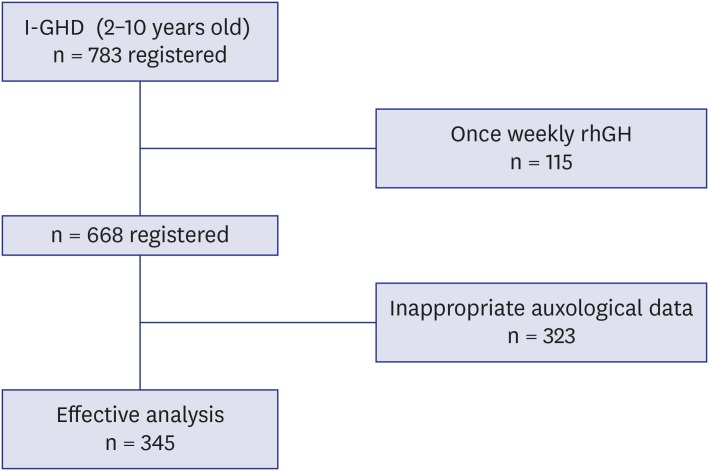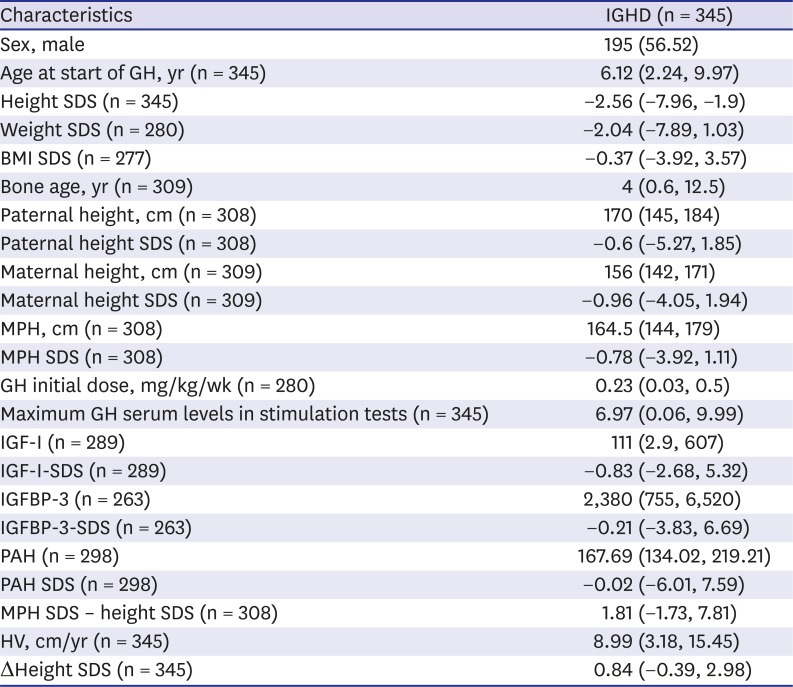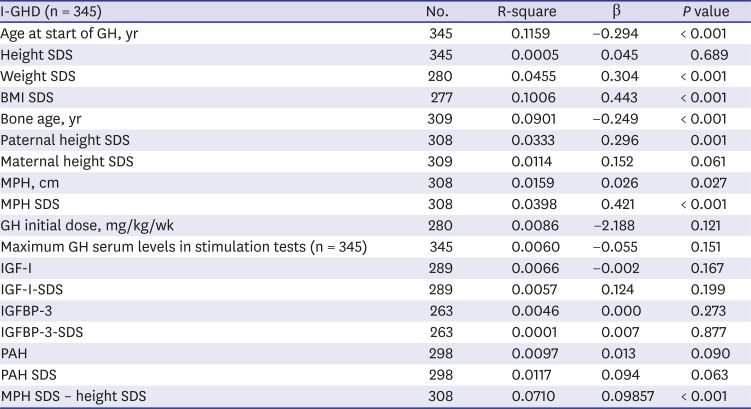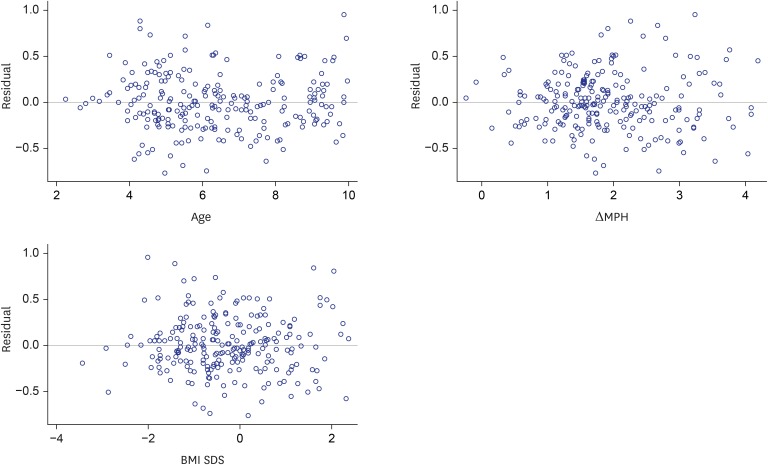1. Ranke MB, Wit JM. Growth hormone - past, present and future. Nat Rev Endocrinol. 2018; 14(5):285–300. PMID:
29546874.

2. GH Research Society. Consensus guidelines for the diagnosis and treatment of growth hormone (GH) deficiency in childhood and adolescence: summary statement of the GH Research Society. J Clin Endocrinol Metab. 2000; 85(11):3990–3993. PMID:
11095419.
3. Reiter EO, Price DA, Wilton P, Albertsson-Wikland K, Ranke MB. Effect of growth hormone (GH) treatment on the near-final height of 1258 patients with idiopathic GH deficiency: analysis of a large international database. J Clin Endocrinol Metab. 2006; 91(6):2047–2054. PMID:
16537676.

4. Kang JC, Choi YS, Choi IK, Kim HS, Kim DH. The effect of growth hormone on patients with growth hormone deficiency and idiopathic short stature. Korean J Pediatr. 2004; 47(3):310–318.
5. Reinehr T, Bechtold-Dalla Pozza S, Bettendorf M, Doerr HG, Gohlke B, Hauffa BP, et al. Impact of overweight on effectiveness of treatment with human growth hormone in growth hormone deficient children: analysis of German KIGS data. Exp Clin Endocrinol Diabetes. 2011; 119(9):544–548. PMID:
22006181.

6. Boguszewski MC, Karlsson H, Wollmann HA, Wilton P, Dahlgren J. Growth hormone treatment in short children born prematurely--data from KIGS. J Clin Endocrinol Metab. 2011; 96(6):1687–1694. PMID:
21430029.

7. Ranke MB, Guilbaud O, Lindberg A, Cole T. Prediction of the growth response in children with various growth disorders treated with growth hormone: analyses of data from the Kabi Pharmacia International Growth Study. International Board of the Kabi Pharmacia International Growth Study. Acta Paediatr Suppl. 1993; 82(Suppl 391):82–88.
8. Chung S, Yoo JH, Choi JH, Rhie YJ, Chae HW, Kim JH, et al. Design of the long-term observational cohort study with recombinant human growth hormone in Korean children: LG Growth Study. Ann Pediatr Endocrinol Metab. 2018; 23(1):43–50. PMID:
29609449.

9. Rhie YJ, Yoo JH, Choi JH, Chae HW, Kim JH, Chung S, et al. Long-term safety and effectiveness of growth hormone therapy in Korean children with growth disorders: 5-year results of LG Growth Study. PLoS One. 2019; 14(5):e0216927. PMID:
31095622.

10. Kim JH, Yun S, Hwang SS, Shim JO, Chae HW, Lee YJ, et al. The 2017 Korean National Growth Charts for children and adolescents: development, improvement, and prospects. Korean J Pediatr. 2018; 61(5):135–149. PMID:
29853938.

11. Hyun SE, Lee BC, Suh BK, Chung SC, Ko CW, Kim HS, et al. Reference values for serum levels of insulin-like growth factor-I and insulin-like growth factor binding protein-3 in Korean children and adolescents. Clin Biochem. 2012; 45(1-2):16–21. PMID:
22032863.

12. Tanner JM, Whitehouse RH, Takaishi M. Standards from birth to maturity for height, weight, height velocity, and weight velocity: British children, 1965. II. Arch Dis Child. 1966; 41(220):613–635. PMID:
5927918.

13. Weisberg S. Applied Linear Regression. 2nd ed. New York, NY: Wiley and Sons;1985.
14. Cook RD, Weisberg S. Residuals and Influence in Regression. New York, NY: Chapman and Hall;1982.
15. de Ridder MA, Stijnen T, Hokken-Koelega AC. Prediction of adult height in growth-hormone-treated children with growth hormone deficiency. J Clin Endocrinol Metab. 2007; 92(3):925–931. PMID:
17179199.

16. Ranke MB, Lindberg A, Chatelain P, Wilton P, Cutfield W, Albertsson-Wikland K, et al. Derivation and validation of a mathematical model for predicting the response to exogenous recombinant human growth hormone (GH) in prepubertal children with idiopathic GH deficiency. KIGS International Board. Kabi Pharmacia International Growth Study. J Clin Endocrinol Metab. 1999; 84(4):1174–1183. PMID:
10199749.
17. Ranke MB, Lindberg A. KIGS International Board. Height at start, first-year growth response and cause of shortness at birth are major determinants of adult height outcomes of short children born small for gestational age and Silver-Russell syndrome treated with growth hormone: analysis of data from KIGS. Horm Res Paediatr. 2010; 74(4):259–266. PMID:
20431273.

18. Ranke MB, Lindberg A. Predicting growth in response to growth hormone treatment. Growth Horm IGF Res. 2009; 19(1):1–11. PMID:
18824380.

19. Cutfield W, Lindberg A, Albertsson Wikland K, Chatelain P, Ranke MB, Wilton P, et al. Final height in idiopathic growth hormone deficiency: the KIGS experience. Acta Paediatr Suppl. 1999; 88(428):72–75.

20. Cohen P, Bright GM, Rogol AD, Kappelgaard AM, Rosenfeld RG. American Norditropin Clinical Trials Group. Effects of dose and gender on the growth and growth factor response to GH in GH-deficient children: implications for efficacy and safety. J Clin Endocrinol Metab. 2002; 87(1):90–98. PMID:
11788629.

21. De Muinck Keizer-Schrama S, Rikken B, Hokken-Koelega A, Wit JM, Drop S. The Dutch Growth Hormone Working Group. Comparative effect of two doses of growth hormone for growth hormone deficiency. Arch Dis Child. 1994; 71(1):12–18. PMID:
8067786.
22. Kriström B, Jansson C, Rosberg S, Albertsson-Wikland K. Swedish Study Group for Growth Hormone Treatment. Growth response to growth hormone (GH) treatment relates to serum insulin-like growth factor I (IGF-I) and IGF-binding protein-3 in short children with various GH secretion capacities. J Clin Endocrinol Metab. 1997; 82(9):2889–2898. PMID:
9284715.
23. Ranke MB, Schweizer R, Elmlinger MW, Weber K, Binder G, Schwarze CP, et al. Significance of basal IGF-I, IGFBP-3 and IGFBP-2 measurements in the diagnostics of short stature in children. Horm Res. 2000; 54(2):60–68. PMID:
11251368.

24. Blum WF, Ranke MB, Kietzmann K, Gauggel E, Zeisel HJ, Bierich JR. A specific radioimmunoassay for the growth hormone (GH)-dependent somatomedin-binding protein: its use for diagnosis of GH deficiency. J Clin Endocrinol Metab. 1990; 70(5):1292–1298. PMID:
1692331.

25. Chanson P, Arnoux A, Mavromati M, Brailly-Tabard S, Massart C, Young J, et al. Reference values for IGF-I serum concentrations: comparison of six immunoassays. J Clin Endocrinol Metab. 2016; 101(9):3450–3458. PMID:
27167056.

26. Ranke MB, Schweizer R, Lindberg A, Price DA, Reiter EO, Albertsson-Wikland K, et al. Insulin-like growth factors as diagnostic tools in growth hormone deficiency during childhood and adolescence: the KIGS experience. Horm Res. 2004; 62(Suppl 1):17–25.

27. Kaspers S, Ranke MB, Han D, Loftus J, Wollmann H, Lindberg A, et al. Implications of a data-driven approach to treatment with growth hormone in children with growth hormone deficiency and Turner syndrome. Appl Health Econ Health Policy. 2013; 11(3):237–249. PMID:
23649890.










 PDF
PDF Citation
Citation Print
Print




 XML Download
XML Download